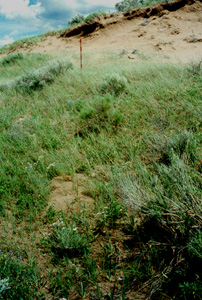Community Field Guide
Scientific Name:
Elymus lanceolatus - Phacelia hastata Herbaceous Vegetation
Common Name:
Thickspike wheatgrass - silverleaf phacelia Herbaceous Vegetation
Community Description
Summary:
The association is a very narrowly defined community, unique to the Centennial Valley Sandhills in southwestern Montana. Elevation ranges from 2,000 to 2,135 m. Sites are active sand dunes and blowouts. Substrate is sand. The sparse to moderately dense vegetation of this seral community is dominated by the medium-tall perennial graminoid Elymus lanceolatus, with 5%-25% cover or higher. Sparse cover (1%-20%) of other species may be present, such as the shrubs Ericameria nauseosa (=Chrysothamnus nauseosus)), Tetradymia canescens, grasses Achnatherum hymenoides (= Oryzopsis hymenoides), Hesperostipa comata (= Stipa comata), and forbs Eriogonum ovalifolium var. purpureum, Linum perenne, Psoralidium tenuiflorum (= Psoralea tenuiflora), and the characteristic species Phacelia hastata. Diagnostic of this association is the dominance of Elymus lanceolatus and the presence of Phacelia hastata in the herbaceous layer.
Environment:
This association has been observed only in the Centennial Valley in a landscape referred to as the Centennial Sandhills. It occurs on sand dune blowouts at elevations around 6,700 feet elevation. These sites may range from foredune apons, to moderately inclined dune faces and lee slope deposition areas. Bare soil (fine-textured sand) cover ranges from 60%-90% and coarse fragments are absent. The soil surface is usually unstable because of a lack of adequate vegetation cover. Parent materials are aeolian sand deposits. Soils are very deep Ustic Torripsamments lacking coarse fragments and are not calcareous. Available water holding capacity is low due to the coarse texture of the substrate.
Vegetation:
Elymus lanceolatus is well represented to abundant within this community type. It and Hesperostipa comata (=Stipa comata) constitute the primary colonizing graminoids on these sites with shifting substrates. Other species that are generally present with cover ranging from 1%-20% include Ericameria nauseosa (=Chrysothamnus nauseosus), Tetradymia canescens, Eriogonum ovalifolium var. celsum, Linum perenne, Phacelia hastata, Psoralea tenuifolia, Achnatherum hymenoides (=Oryzopsis hymenoides), and Hesperostipa comata.
Range:
This is a very narrowly defined community type, unique to the Centennial Valley Sandhills; this is a high (>7,000 feet) and cold valley experiencing prolonged and severe episodes of cold-air ponding and deep snow accumulation.
Global Rank: G2 State Rank: S2
Global Rank Comments:
This is a very unique environment supporting a community type dependent on a specific suite of disturbance factors applied at regular intervals for its maintenance; in turn there are a number of sensitive species that, for Montana, occur only in this seral community. Were one to suppress fire and remove cattle over this landscape, succession would lead to stable Artemisia tridentata ssp. vaseyana- and Artemisia tripartita-dominated communities and the probable loss of the sensitive species; species dominant of the seral community could colonize from populations outside the Centennial Sandhills but the unique composition would by then be lost.
Community References
Identifier:
CEGL001745
Author:
99-11-16 / S. V. Cooper, MTNHP
Citations:
Cooper et al. 1999, DeVelice 1992
View Detailed Citation Information | New Community Search | NatureServe Explorer Community Information
This information is from the:
Montana Natural Heritage Program
Montana State Library--Natural Resource Information System
1515 East Sixth Ave., Helena, MT 59620-1800
406 444-3989
mtnhp.org
mtnhp@mt.gov






